

Compact Muon Solenoid
LHC, CERN
| CMS-B2G-17-009 ; CERN-EP-2017-338 | ||
| Search for single production of vector-like quarks decaying to a b quark and a Higgs boson | ||
| CMS Collaboration | ||
| 5 February 2018 | ||
| JHEP 06 (2018) 031 | ||
| Abstract: A search is presented for single production of heavy vector-like quarks (B) that decay to a Higgs boson and a b quark, with the Higgs boson decaying to a highly boosted $ \mathrm{b\bar{b}} $ pair reconstructed as a single collimated jet. The analysis is based on data collected by the CMS experiment in proton-proton collisions at $\sqrt{s} = $ 13 TeV, corresponding to an integrated luminosity of 35.9 fb$^{-1}$. The data are consistent with background expectations, and upper limits at 95% confidence level on the product of the B quark cross section and the branching fraction are obtained in the range 1.28-0.07 pb, for a narrow B quark with a mass between 700 and 1800 GeV. The production of B quarks with widths of 10, 20 and 30% of the resonance mass is also considered, and the sensitivities obtained are similar to those achieved in the narrow width case. This is the first search at the CERN LHC for the single production of a B quark through its fully hadronic decay channel, and the first study considering finite resonance widths of the B quark. | ||
| Links: e-print arXiv:1802.01486 [hep-ex] (PDF) ; CDS record ; inSPIRE record ; CADI line (restricted) ; | ||
| Figures | |
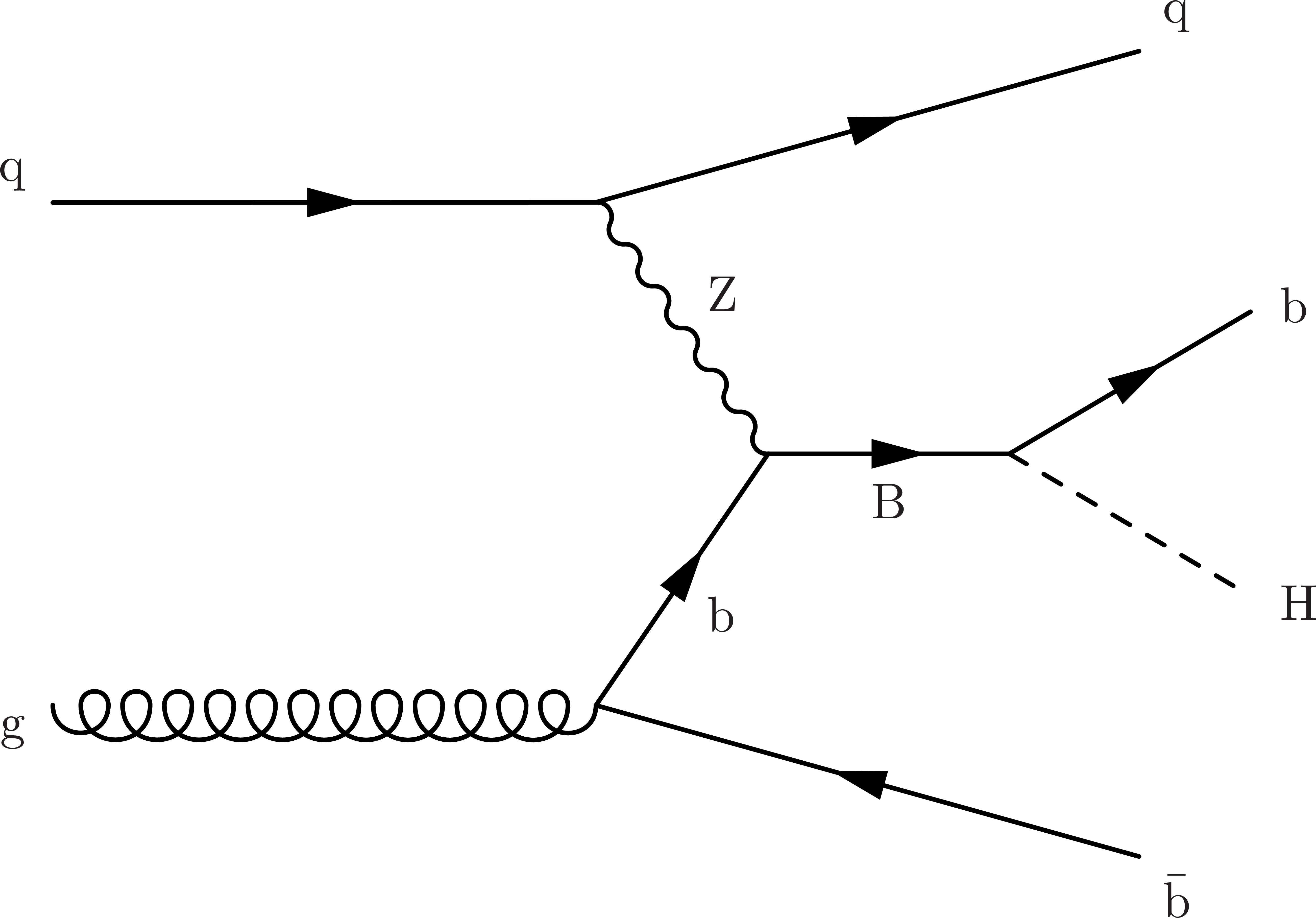
png pdf |
Figure 1:
The leading-order Feynman diagram for the production of a single vector-like B quark in association with a b quark and light-flavour quark, and its decay to a Higgs boson and a b quark. |

png pdf |
Figure 2:
The b-tagged subjet multiplicity of AK8 jets in events passing preselection criteria. The lower panel shows the ratio of data to the MC background prediction. The normalization of the contributions from signals at $ {m_{{{\mathrm {B}}}}}= $ 1 and 1.8 TeV is multiplied by a factor of 500. Background events are normalized to data. Only the statistical uncertainties are taken into consideration here, and they are too small to be visible. |

png pdf |
Figure 3:
Multiplicity of forward jets before event categorization. The normalization of the signal contributions is multiplied by a factor of 500. The simulated background predictions are normalized to data. The lower panel shows the ratio of data to background. We show only the statistical uncertainties. |

png pdf |
Figure 4:
Distribution in the reconstructed B quark mass, after applying all selections to events with no forward jets (left) and to events with at least one forward jet (right), compared to the background distributions estimated before fitting. The upper and lower plots refer to the low- and high-mass $ {m_{{{\mathrm {B}}}}} $ analyses, respectively. The expectations for signal MC events are given by the blue histogram lines. Different contributions to background are indicated by the colour-filled histograms. The grey-hatched error band shows total uncertainties in the background expectation. The ratios of observations to background expectations are given in the lower panels, together with the total uncertainties prior to fitting, indicated by the grey-hatched band. |

png pdf |
Figure 4-a:
Distribution in the reconstructed B quark mass, after applying all selections to events with no forward jet, compared to the background distributions estimated before fitting. The plot refers to the low-mass $ {m_{{{\mathrm {B}}}}} $ analysis. The expectations for signal MC events are given by the blue histogram lines. Different contributions to background are indicated by the colour-filled histograms. The grey-hatched error band shows total uncertainties in the background expectation. The ratio of observations to background expectations is given in the lower panel, together with the total uncertainties prior to fitting, indicated by the grey-hatched band. |
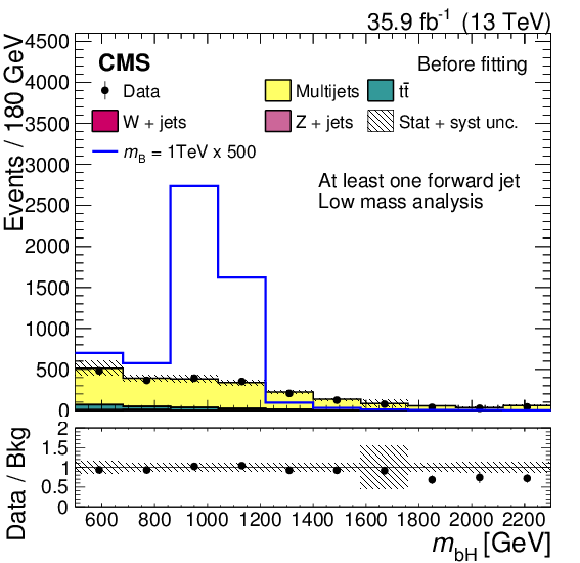
png pdf |
Figure 4-b:
Distribution in the reconstructed B quark mass, after applying all selections to events with at least one forward jet, compared to the background distributions estimated before fitting. The plot refers to the low-mass $ {m_{{{\mathrm {B}}}}} $ analysis. The expectations for signal MC events are given by the blue histogram lines. Different contributions to background are indicated by the colour-filled histograms. The grey-hatched error band shows total uncertainties in the background expectation. The ratio of observations to background expectations is given in the lower panel, together with the total uncertainties prior to fitting, indicated by the grey-hatched band. |
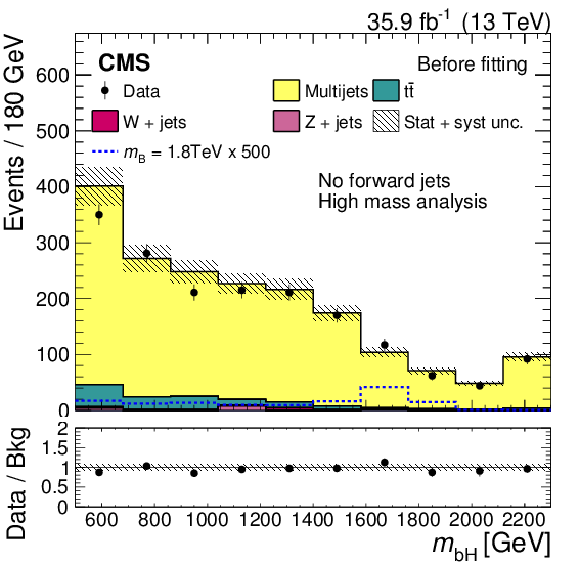
png pdf |
Figure 4-c:
Distribution in the reconstructed B quark mass, after applying all selections to events with no forward jet, compared to the background distributions estimated before fitting. The plot refers to the high-mass $ {m_{{{\mathrm {B}}}}} $ analysis. The expectations for signal MC events are given by the blue histogram lines. Different contributions to background are indicated by the colour-filled histograms. The grey-hatched error band shows total uncertainties in the background expectation. The ratio of observations to background expectations is given in the lower panel, together with the total uncertainties prior to fitting, indicated by the grey-hatched band. |

png pdf |
Figure 4-d:
Distribution in the reconstructed B quark mass, after applying all selections to events with at least one forward jet, compared to the background distributions estimated before fitting. The plot refers to the high-mass $ {m_{{{\mathrm {B}}}}} $ analysis. The expectations for signal MC events are given by the blue histogram lines. Different contributions to background are indicated by the colour-filled histograms. The grey-hatched error band shows total uncertainties in the background expectation. The ratio of observations to background expectations is given in the lower panel, together with the total uncertainties prior to fitting, indicated by the grey-hatched band. |
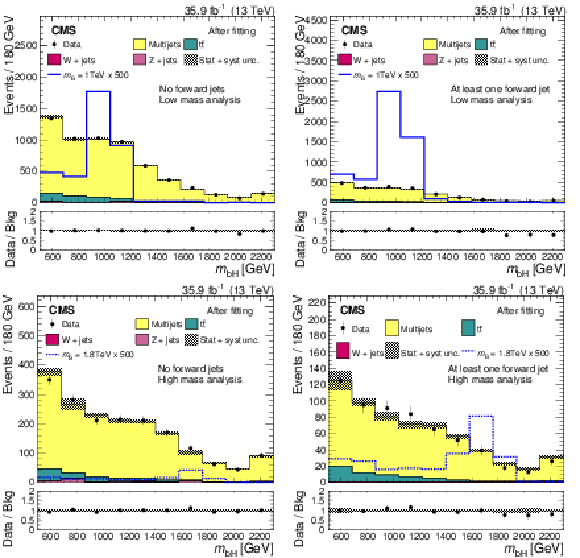
png pdf |
Figure 5:
Distribution in the reconstructed B quark mass after applying all selections to events with no forward jets (left) and to events with at least one forward jet (right), compared to the background distributions estimated after fitting. The upper and lower plots refer to the low- and high-$ {m_{{{\mathrm {B}}}}} $ analyses, respectively. The expectations for signal MC events are given by the blue lines. Different contributions to background are indicated by the colour-filled histograms. The grey-hatched error band shows total uncertainties in the background expectation. The ratios of the observations to background expectations are given in the lower panels, together with the total uncertainties after fitting, indicated by the grey-hatched band. |
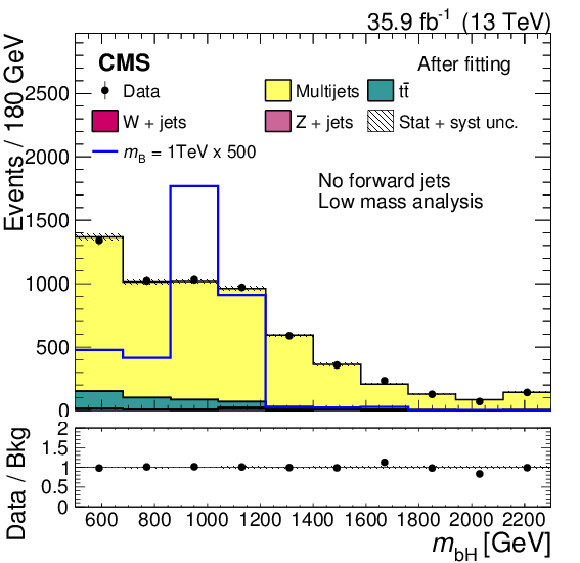
png pdf |
Figure 5-a:
Distribution in the reconstructed B quark mass after applying all selections to events with no forward jet, compared to the background distributions estimated after fitting. The plot refers to the low-$ {m_{{{\mathrm {B}}}}} $ analysis. The expectations for signal MC events are given by the blue lines. Different contributions to background are indicated by the colour-filled histograms. The grey-hatched error band shows total uncertainties in the background expectation. The ratio of the observations to background expectations is given in the lower panel, together with the total uncertainties after fitting, indicated by the grey-hatched band. |
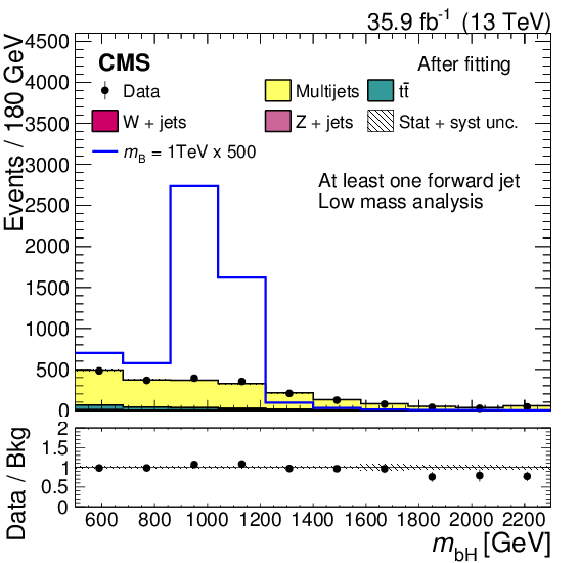
png pdf |
Figure 5-b:
Distribution in the reconstructed B quark mass after applying all selections to events with at least one forward jet, compared to the background distributions estimated after fitting. The plot refers to the low-$ {m_{{{\mathrm {B}}}}} $ analysis. The expectations for signal MC events are given by the blue lines. Different contributions to background are indicated by the colour-filled histograms. The grey-hatched error band shows total uncertainties in the background expectation. The ratio of the observations to background expectations is given in the lower panel, together with the total uncertainties after fitting, indicated by the grey-hatched band. |
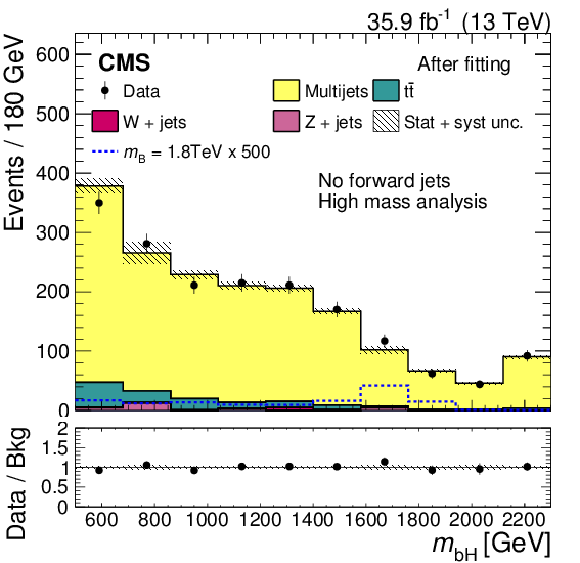
png pdf |
Figure 5-c:
Distribution in the reconstructed B quark mass after applying all selections to events with no forward jet, compared to the background distributions estimated after fitting. The plot refers to the high-$ {m_{{{\mathrm {B}}}}} $ analysis. The expectations for signal MC events are given by the blue lines. Different contributions to background are indicated by the colour-filled histograms. The grey-hatched error band shows total uncertainties in the background expectation. The ratio of the observations to background expectations is given in the lower panel, together with the total uncertainties after fitting, indicated by the grey-hatched band. |

png pdf |
Figure 5-d:
Distribution in the reconstructed B quark mass after applying all selections to events with at least one forward jet, compared to the background distributions estimated after fitting. The plot refers to the high-$ {m_{{{\mathrm {B}}}}} $ analysis. The expectations for signal MC events are given by the blue lines. Different contributions to background are indicated by the colour-filled histograms. The grey-hatched error band shows total uncertainties in the background expectation. The ratio of the observations to background expectations is given in the lower panel, together with the total uncertainties after fitting, indicated by the grey-hatched band. |
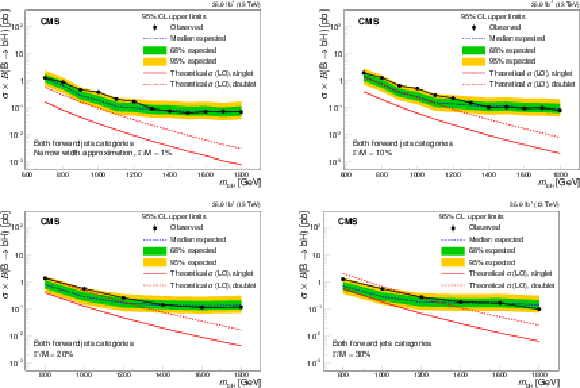
png pdf |
Figure 6:
The median observed and expected 95% CL upper limits on the product of the B quark production cross section and branching fraction as a function of the signal mass, assuming narrow-width resonances (upper-left) and widths of 10 (upper-right), 20 (lower-left), and 30% (lower-right) of the resonance mass for the B quark. The results are shown for the combination of 0 and $ > $0 forward-jet categories. The continuous red curves correspond to the theoretical expectations for singlet and doublet models. |

png pdf |
Figure 6-a:
The median observed and expected 95% CL upper limits on the product of the B quark production cross section and branching fraction as a function of the signal mass, assuming narrow-width resonances. The results are shown for the combination of 0 and $ > $0 forward-jet categories. The continuous red curves correspond to the theoretical expectations for singlet and doublet models. |

png pdf |
Figure 6-b:
The median observed and expected 95% CL upper limits on the product of the B quark production cross section and branching fraction as a function of the signal mass, assuming a width of 10% of the resonance mass for the B quark. The results are shown for the combination of 0 and $ > $0 forward-jet categories. The continuous red curves correspond to the theoretical expectations for singlet and doublet models. |
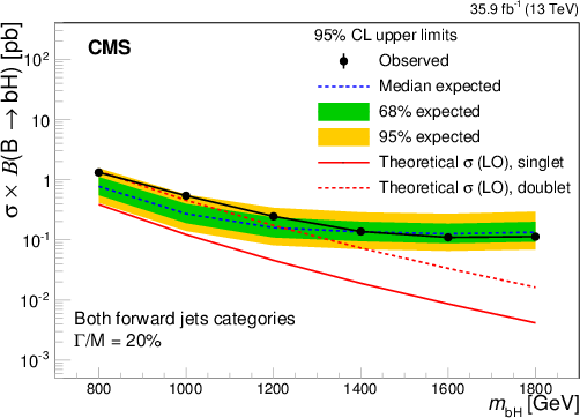
png pdf |
Figure 6-c:
The median observed and expected 95% CL upper limits on the product of the B quark production cross section and branching fraction as a function of the signal mass, assuming a width of 20% of the resonance mass for the B quark. The results are shown for the combination of 0 and $ > $0 forward-jet categories. The continuous red curves correspond to the theoretical expectations for singlet and doublet models. |

png pdf |
Figure 6-d:
The median observed and expected 95% CL upper limits on the product of the B quark production cross section and branching fraction as a function of the signal mass, assuming a width of 30% of the resonance mass for the B quark. The results are shown for the combination of 0 and $ > $0 forward-jet categories. The continuous red curves correspond to the theoretical expectations for singlet and doublet models. |
| Tables | |
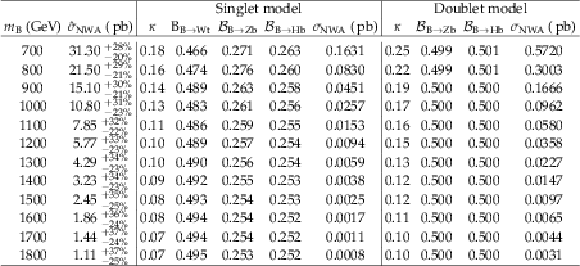
png pdf |
Table 1:
Cross sections for $ {\mathrm {p}} {\mathrm {p}}\to {{\mathrm {B}}} {\mathrm {b}} {\mathrm {q}}$, with the ratio $\Gamma _{{{\mathrm {B}}}}/ {m_{{{\mathrm {B}}}}}$ fixed to 1% (NWA). The couplings and branching fractions in simplified models are calculated using the equations in the text. The uncertainties in the production cross sections correspond to the halving and doubling of the QCD renormalization and factorization scales |
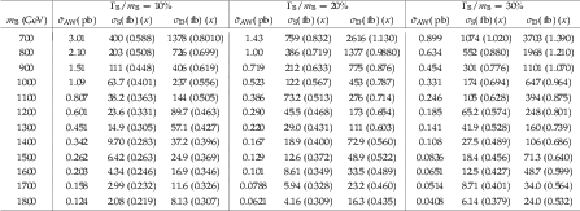
png pdf |
Table 2:
Cross sections for $ {\mathrm {p}} {\mathrm {p}}\to {{\mathrm {B}}} {\mathrm {b}} {\mathrm {q}}$ for three values of the $\Gamma _{{{\mathrm {B}}}}/ {m_{{{\mathrm {B}}}}} $ ratio. The conditions assume that singlets and doublets have $\kappa _{{\mathrm {W}}} = \kappa _{{\mathrm {Z}}} = \kappa _{{\mathrm {H}}}\equiv \kappa $, $\kappa _{{\mathrm {W}}} = $ 0 and $\kappa _{{\mathrm {Z}}} = \kappa _{{\mathrm {H}}}\equiv \kappa $, respectively. For each $\Gamma _{{{\mathrm {B}}}}/ {m_{{{\mathrm {B}}}}} $, we provide the values of $\tilde\sigma _\text {AW}$ and of the physical cross sections for both the singlet and doublet models, $\sigma _\text {S}$ and $\sigma _\text {D}$ respectively. The uncertainties in the production cross sections correspond to the halving and doubling of the QCD renormalization and factorization scales. The values of $\kappa $ are listed in the parentheses. |

png pdf |
Table 3:
Summary of systematic uncertainties in background events. The quantification of the effects quoted in the table reflects the uncertainties in the event yields. All uncertainties are considered in the simulated background events, except the one on background estimation that affects only the data-based estimate of the multijet process. All the systematic uncertainties apply to both categories of forward-jet multiplicity, except for the case of the modelling of the forward jets, where the first entry corresponds to the category with no forward jets, and the second entry to the category with at least one jet in the forward region. |
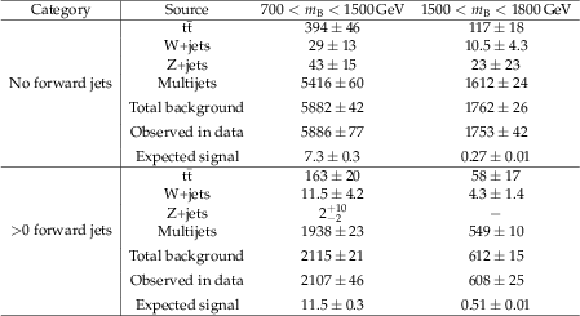
png pdf |
Table 4:
Observed and expected fitted number of events in the signal ranges of 700 $ < {m_{{{\mathrm {B}}}}} < $ 1500 and 1500 $ < {m_{{{\mathrm {B}}}}} < $ 1800 GeV, and expected signal at $ {m_{{{\mathrm {B}}}}}= $ 1000 and 1800 GeV. The multijet background is obtained from data, while the yields for the other sources of background are obtained from MC simulation. The combined statistical and systematic uncertainties correspond to the quadrature of the statistical and systematic uncertainties. |
| Summary |
|
A search has been presented for electroweak production of vector-like B quarks with charge $-1/3\,e$, decaying to a bottom quark and a Higgs boson (H). The analysis uses a data sample corresponding to an integrated luminosity of 35.9 fb$^{-1}$ , collected in pp collisions at $\sqrt{s} = $ 13 TeV. No significant deviations are observed relative to the standard model prediction, and upper limits are placed on the product of the cross section and the branching fraction of the B quark. Expected and observed limits at 95% confidence level vary from 1.20 to 0.07 pb and from 1.28 to 0.07 pb, respectively, for B quark masses in the range considered, which extends from 700 to 1800 GeV. The search is performed under the hypothesis of a singlet or doublet B quark of narrow width decaying to Hb with a branching fraction of approximately 25%. The possibility of having non-negligible resonant widths is also studied. Limits obtained on the production of B quarks with widths of 10, 20, and 30% of the resonance mass are comparable to those found for the narrow-width approximation. This search extends existing knowledge on vector-like quarks, by interpreting the results in a new theoretical framework with non-negligible resonance widths, and investigating the final state with a bottom quark and a Higgs boson for the first time. |
| References | ||||
| 1 | ATLAS Collaboration | Observation of a new particle in the search for the standard model Higgs boson with the ATLAS detector at the LHC | PLB 716 (2012) 1 | 1207.7214 |
| 2 | CMS Collaboration | Observation of a new boson at a mass of 125 GeV with the CMS experiment at the LHC | PLB 716 (2012) 30 | CMS-HIG-12-028 1207.7235 |
| 3 | ATLAS and CMS Collaborations | Combined measurement of the Higgs boson mass in pp collisions at $ \sqrt{s}= $ 7 and 8 TeV with the ATLAS and CMS experiments | PRL 114 (2015) 191803 | 1503.07589 |
| 4 | J. A. Aguilar-Saavedra, R. Benbrik, S. Heinemeyer, and M. P\'erez-Victoria | Handbook of vectorlike quarks: mixing and single production | PRD 88 (2013) 094010 | 1306.0572 |
| 5 | M. Schmaltz and D. Tucker-Smith | Little Higgs review | Ann. Rev. Nucl. Part. Sci. 55 (2005) 229 | hep-ph/0502182 |
| 6 | D. B. Kaplan and H. Georgi | SU(2) x U(1) breaking by vacuum misalignment | PLB 136 (1984) 183 | |
| 7 | H. Georgi, D. B. Kaplan, and P. Galison | Calculation of the composite Higgs mass | PLB 143 (1984) 152 | |
| 8 | M. J. Dugan, H. Georgi, and D. B. Kaplan | Anatomy of a composite Higgs model | NPB 254 (1985) 299 | |
| 9 | J. A. Aguilar-Saavedra | Identifying top partners at LHC | JHEP 11 (2009) 030 | 0907.3155 |
| 10 | A. De Simone, O. Matsedonskyi, R. Rattazzi, and A. Wulzer | A first top partner hunter's guide | JHEP 04 (2013) 004 | 1211.5663 |
| 11 | M. Buchkremer, G. Cacciapaglia, A. Deandrea, and L. Panizzi | Model independent framework for searches of top partners | NPB 876 (2013) 376 | 1305.4172 |
| 12 | G. D. Kribs, T. Plehn, M. Spannowsky, and T. M. P. Tait | Four generations and Higgs physics | PRD 76 (2007) 075016 | 0706.3718 |
| 13 | S. Banerjee, M. Frank, and S. K. Rai | Higgs data confronts sequential fourth generation fermions in the Higgs triplet model | PRD 89 (2014) 075005 | 1312.4249 |
| 14 | ATLAS and CMS Collaborations | Measurements of the Higgs boson production and decay rates and constraints on its couplings from a combined ATLAS and CMS analysis of the LHC pp collision data at $ \sqrt{s}= $ 7 and 8 TeV | JHEP 08 (2016) 045 | 1606.02266 |
| 15 | O. Eberhardt et al. | Joint analysis of Higgs decays and electroweak precision observables in the standard model with a sequential fourth generation | PRD 86 (2012) 013011 | 1204.3872 |
| 16 | CMS Collaboration | Searches for Higgs bosons in pp collisions at $ \sqrt{s} = $ 7 and 8 TeV in the context of four-generation and fermiophobic models | PLB 725 (2013) 36 | CMS-HIG-12-013 1302.1764 |
| 17 | ATLAS Collaboration | Search for vector-like B quarks in events with one isolated lepton, missing transverse momentum and jets at $ \sqrt{s}= $ 8 TeV with the ATLAS detector | PRD 91 (2015) 112011 | 1503.05425 |
| 18 | ATLAS Collaboration | Search for pair production of a new heavy quark that decays into a W boson and a light quark in pp collisions at $ \sqrt{s} = $ 8 TeV with the ATLAS detector | PRD 92 (2015) 112007 | 1509.04261 |
| 19 | ATLAS Collaboration | Search for pair and single production of new heavy quarks that decay to a Z boson and a third-generation quark in pp collisions at $ \sqrt{s}= $ 8 TeV with the ATLAS detector | JHEP 11 (2014) 104 | 1409.5500 |
| 20 | ATLAS Collaboration | Search for single production of a vector-like quark via a heavy gluon in the 4b final state with the ATLAS detector in pp collisions at $ \sqrt{s} = $ 8 TeV | PLB 758 (2016) 249 | 1602.06034 |
| 21 | ATLAS Collaboration | Search for single production of vector-like quarks decaying into Wb in pp collisions at $ \sqrt{s} = $ 8 TeV with the ATLAS detector | EPJC. 76 (2016) 442 | 1602.05606 |
| 22 | ATLAS Collaboration | Search for the production of single vector-like and excited quarks in the Wt final state in pp collisions at $ \sqrt{s} = $ 8 TeV with the ATLAS detector | JHEP 02 (2016) 110 | 1510.02664 |
| 23 | CMS Collaboration | Search for vector-like charge 2/3 T quarks in proton-proton collisions at $ \sqrt{s} = $ 8 TeV | PRD 93 (2016) 012003 | CMS-B2G-13-005 1509.04177 |
| 24 | CMS Collaboration | Search for pair-produced vectorlike B quarks in proton-proton collisions at $ \sqrt{s} = $ 8 TeV | PRD 93 (2016) 112009 | CMS-B2G-13-006 1507.07129 |
| 25 | CMS Collaboration | Search for top-quark partners with charge 5/3 in the same-sign dilepton final state | PRL 112 (2014) 171801 | CMS-B2G-12-012 1312.2391 |
| 26 | CMS Collaboration | Search for single production of vector-like quarks decaying to a Z boson and a top or a bottom quark in proton-proton collisions at $ \sqrt{s}= $ 13 TeV | JHEP 05 (2017) 029 | CMS-B2G-16-001 1701.07409 |
| 27 | CMS Collaboration | Search for single production of a heavy vector-like T quark decaying to a Higgs boson and a top quark with a lepton and jets in the final state | PLB 771 (2017) 80 | CMS-B2G-15-008 1612.00999 |
| 28 | CMS Collaboration | Search for electroweak production of a vector-like quark decaying to a top quark and a higgs boson using boosted topologies in fully hadronic final states | JHEP 04 (2017) 136 | CMS-B2G-16-005 1612.05336 |
| 29 | CMS Collaboration | Search for single production of vector-like quarks decaying into a b quark and a W boson in proton-proton collisions at $ \sqrt s = $ 13 TeV | PLB 772 (2017) 634 | CMS-B2G-16-006 1701.08328 |
| 30 | CMS Collaboration | The CMS experiment at the CERN LHC | JINST 3 (2008) S08004 | CMS-00-001 |
| 31 | CMS Collaboration | The CMS trigger system | JINST 12 (2017) P01020 | CMS-TRG-12-001 1609.02366 |
| 32 | CMS Collaboration | Particle-flow reconstruction and global event description with the CMS detector | JINST 12 (2017) P10003 | CMS-PRF-14-001 1706.04965 |
| 33 | M. Cacciari, G. P. Salam, and G. Soyez | The anti-$ {k_{\mathrm{T}}} $ jet clustering algorithm | JHEP 04 (2008) 063 | 0802.1189 |
| 34 | CMS Collaboration | Pileup removal algorithms | CMS-PAS-JME-14-001 | CMS-PAS-JME-14-001 |
| 35 | M. Cacciari, G. P. Salam, and G. Soyez | FastJet user manual | EPJC 72 (2012) 1896 | 1111.6097 |
| 36 | CMS Collaboration | Jet algorithms performance in 13 TeV data | CMS-PAS-JME-16-003 | CMS-PAS-JME-16-003 |
| 37 | CMS Collaboration | Identification of heavy-flavour jets with the CMS detector in pp collisions at 13 TeV | Submitted to \it JINST | CMS-BTV-16-002 1712.07158 |
| 38 | S. D. Ellis, C. K. Vermilion, and J. R. Walsh | Techniques for improved heavy particle searches with jet substructure | PRD 80 (2009) 051501 | 0903.5081 |
| 39 | S. Catani, Y. L. Dokshitzer, M. H. Seymour, and B. R. Webber | Longitudinally-invariant k$ _\perp $-clustering algorithms for hadron-hadron collisions | NPB 406 (1993) 187 | |
| 40 | M. Dasgupta, A. Fregoso, S. Marzani, and G. P. Salam | Towards an understanding of jet substructure | JHEP 09 (2013) 029 | 1307.0007 |
| 41 | A. J. Larkoski, S. Marzani, G. Soyez, and J. Thaler | Soft drop | JHEP 05 (2014) 146 | 1402.2657 |
| 42 | J. Alwall et al. | The automated computation of tree-level and next-to-leading order differential cross sections, and their matching to parton shower simulations | JHEP 07 (2014) 079 | 1405.0301 |
| 43 | T. Sjostrand et al. | An introduction to PYTHIA 8.2 | CPC 191 (2015) 159 | 1410.3012 |
| 44 | P. Skands, S. Carrazza, and J. Rojo | Tuning PYTHIA 8.1: the Monash 2013 tune | Euro. Phys. J. C 74 (2014) 3024 | 1404.5630 |
| 45 | CMS Collaboration | Event generator tunes obtained from underlying event and multiparton scattering measurements | Euro. Phys. J. C 76 (2016) 155 | CMS-GEN-14-001 1512.00815 |
| 46 | P. Nason | A new method for combining NLO QCD with shower Monte Carlo algorithms | JHEP 11 (2004) 040 | hep-ph/0409146 |
| 47 | S. Frixione, P. Nason, and G. Ridolfi | A positive-weight next-to-leading-order Monte Carlo for heavy flavour hadroproduction | JHEP 09 (2007) 126 | 0707.3088 |
| 48 | S. Frixione, P. Nason, and C. Oleari | Matching NLO QCD computations with parton shower simulations: the POWHEG method | JHEP 11 (2007) 070 | 0709.2092 |
| 49 | S. Alioli, P. Nason, C. Oleari, and E. Re | A general framework for implementing NLO calculations in shower Monte Carlo programs: the POWHEG BOX | JHEP 06 (2010) 043 | 1002.2581 |
| 50 | M. Czakon and A. Mitov | Top++: A program for the calculation of the top-pair cross-section at hadron colliders | CPC 185 (2014) 2930 | 112.5675 |
| 51 | Y. Li and F. Petriello | Combining QCD and electroweak corrections to dilepton production in FEWZ | PRD 86 (2012) 094034 | 1208.5967 |
| 52 | C. Degrande et al. | UFO --- The Universal FeynRules Output | CPC 183 (2012) 1201 | 1108.2040 |
| 53 | O. Matsedonskyi, G. Panico, and A. Wulzer | On the interpretation of top partners searches | JHEP 12 (2014) 097 | 1409.0100 |
| 54 | NNPDF Collaboration | Parton distributions from high-precision collider data | EPJC 77 (2017) 663 | 1706.00428 |
| 55 | GEANT4 Collaboration | $ GEANT4--a $ simulation toolkit | NIMA 506 (2003) 250 | |
| 56 | C. Y. Chen, S. Dawson, and E. Furlan | Vectorlike fermions and Higgs effective field theory revisited | PRD 96 (2017) 015006 | 1703.06134 |
| 57 | J. Pumplin et al. | New generation of parton distributions with uncertainties from global QCD analysis | JHEP 07 (2002) 012 | hep-ph/0201195 |
| 58 | CMS Collaboration | CMS luminosity measurements for the 2016 data taking period | CMS-PAS-LUM-17-001 | CMS-PAS-LUM-17-001 |
| 59 | M. Botje et al. | The PDF4LHC Working Group Interim Recommendations | 1101.0538 | |
| 60 | S. Alekhin et al. | The PDF4LHC Working Group Interim Report | 1101.0536 | |
| 61 | NNPDF Collaboration | Parton distributions for the LHC Run II | JHEP 04 (2015) 040 | 1410.8849 |
| 62 | T. Junk | Confidence level computation for combining searches with small statistics | NIMA 434 (1999) 435 | hep-ex/9902006 |
| 63 | A. L. Read | Presentation of search results: the $ CL_s $ technique | in Durham IPPP Workshop: Advanced Statistical Techniques in Particle Physics, p. 2693 Durham, UK, March, 2002 [JPG 28 (2002) 2693] | |
| 64 | G. Cowan, K. Cranmer, E. Gross, and O. Vitells | Asymptotic formulae for likelihood-based tests of new physics | EPJC 71 (2011) 1554 | 1007.1727 |
| 65 | J. S. Conway | Incorporating nuisance parameters in likelihoods for multisource spectra | in Proceedings, PHYSTAT 2011 Workshop on Statistical Issues Related to Discovery Claims in Search Experiments and Unfolding, CERN,Geneva, Switzerland 17-20 January 2011, p. 115 2011 | 1103.0354 |

|
Compact Muon Solenoid LHC, CERN |

|

|

|

|

|

|